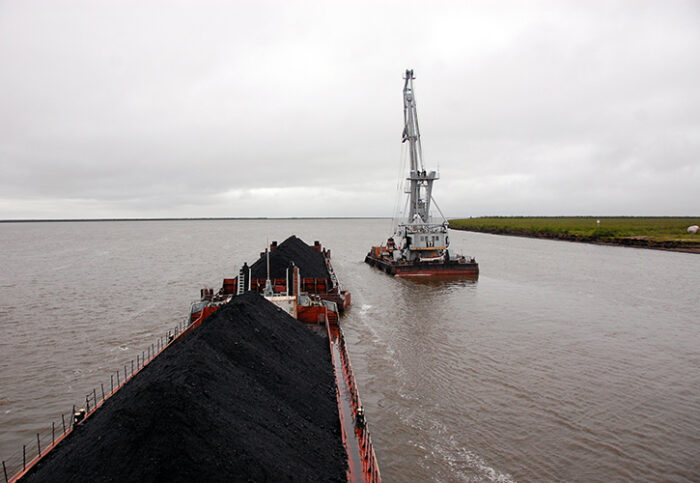Inland Waterway Traffic Is Rising, and Workers’ Comp Risks Will Follow. Here’s How to Adapt

As businesses seek to minimize transportation costs and, in some cases, shorten supply chains, the U.S.’s inland waterways are seeing a lot more traffic.
That move has been accelerated by infrastructure investment at the federal, state and local levels, including the installation of dams, dockage, locks, piers and other marine construction, as well as dredging work to deepen navigation channels to cater to increasingly large vessels.
The federal government has also been targeting the main trade routes, and new legislation introduced in Congress is aimed at establishing a new body to promote economic growth and recovery across the Great Lakes, in just one example.
The increased commerce and transit, totaling almost 830 million tons of cargo annually, also exposes waterfront workers to far greater risk of injury.
The seamen and other maritime laborers who work daily — often with heavy or dangerous equipment in high-risk environments like tugboats, barges, fishing boats, drilling rigs and platforms on inland waterways — face a host of workplace hazards. These include diving and dredge accidents, falls, heavy machinery malfunctions or exposure to toxic chemicals such as asbestos or benzene.
Such incidents can result in serious injury, including lacerations, burns, torn or strained muscles and ligaments, spinal cord injuries, permanent paralysis and slipped, herniated, ruptured or bulging discs, and even death. Subsequently, waterfront workers may find themselves temporarily or permanently out of work, incurring lost wages and racking up huge medical bills.
Factor In Climate Change
These workers’ compensation exposures have been exacerbated by climate change, which on the one hand is causing extreme rain and flooding, and contributing to higher water levels on rivers. Flooding and high-water marks are now happening in more places and more regularly than before, almost without warning.
This has been nowhere more acutely felt than in the Mississippi River Basin, which has been subjected to unprecedented weather extremes. Flash flooding in St. Louis broke a century-old rainfall record last summer, while historic flooding has decimated many eastern Kentucky communities.
Increasingly, dockside workers face dangerous working conditions due to unpredictable weather patterns.
All signs indicate that the climate change issue is to going to get much worse; parts of the Mississippi River Basin now receive up to eight more inches of rain annually than they did 50 years ago, according to research by Climate Central.
It’s also falling harder in many places as a warmer atmosphere causes greater precipitation in shorter timeframes. This growing frequency and severity of flooding is causing sediment to clog up navigation channels, making it harder for vessels to access.
On the other side of the climate change coin, drought is affecting other areas, leading to lower water levels and a different set of workers’ compensation exposures.
“Historically low water levels in the central U.S. led to extensive delays in transport, barges ran aground and were stuck for weeks, and the transportation supply infrastructure was hobbled,” said Joe Paduda, principal of Health Strategy Associates.
“Barges had to be off-loaded while still in transit to enable them to get by shallow areas, increasing potential injuries due to nonstandard loading and unloading operations.
“These issues likely led to higher payroll costs and thus higher workers’ comp premiums. It is possible additional injuries occurred,” Paduda said.
And Don’t Forget Underinsurance
A bigger problem, however, is that many inland waterway workers are uninsured or underinsured. While there is plenty of workers’ compensation insurance available, many companies aren’t accessing the right type or level of coverage. In a few cases, they decide against securing cover due to the expense.
“None of the states that regulate workers’ compensation laws or the U.S. Department of Labor have the resources to patrol the maritime areas to check for insurance,” said Jack Martone, senior vice president at The American Equity Underwriters Inc., an Amwins Group company.
“The problem is that there are a lot of nonspecialist construction companies that are being brought in by government to carry out this marine construction work, but they either don’t have enough or the right insurance,” Martone said.
“For example, if you’re going to build a bridge and your workers are going to be working off a vessel, if someone gets injured and you don’t have maritime employers’ liability insurance in place, they can sue you under the Jones Act,” Martone added. “That happened in a case in Indiana where a worker sued his employer for $35 million after suffering a life-changing injury in his workplace.”
The problem is that, because such companies don’t specialize in marine work, they often don’t understand the risk. Thus, they end up with the wrong coverage.
“It really comes down to the company understanding the risk and making sure that they are properly insured against it,” said Richard Lang, associate director at Trident Marine Managers. “I would estimate that about 20% are either underinsured or uninsured.”
Seamen are protected against injuries incurred under the Jones Act, enabling them to sue a negligent employer. Those that spend less than 30% of their time working aboard an operable vessel can seek compensation under the Longshore and Harbor Workers’ Compensation Act, which is administered by the U.S. Department of Labor.
Therefore, it’s essential that employers have the right workers’ compensation program in place to cover employees in the event of a workplace injury. With the help of their broker or insurer, they can carry out a thorough risk assessment on the work they do and their working environment to determine their exposures, and thus secure the appropriate coverage.
Insureds also need to engage their broker and insurer to ensure they have the best possible safety and loss control programs. The success of such programs relative to those in other transportation industries is borne out by the fact that, on a million-ton-mile basis, there are 21.9 rail fatalities and 79.3 truck fatalities for every one fatality on the waterways system, according to the U.S. Department of Agriculture.
“The best companies work with safety and loss control management specialists who come out to risk assess and make the jobsites safer for workers,” said Martone. “And if they have the right coverage too, they are in a pretty good place.” &












